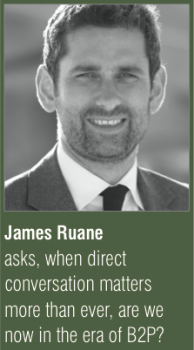
IMPRESSIVE CAMPAIGNS RELY ON POWERFUL STORYTELLING
"Powerful storytelling is at the core of almost every impressive campaign"
Business to person becomes more relevant than business to business or business to consumer, James Ruane says
 B2B marketing has a history of being perceived as somewhat inferior to its B2C counterpart. Consumer marketers are widely considered to be further ahead in capitalising on audience insights and implementing science-based creativity, and in the art of brand storytelling. Historically the flashy consumer campaigns have garnered the most attention both within and outside the industry. While this may have once been the case, in today’s world the differences between the disciplines are being rapidly eroded.
B2B marketing has a history of being perceived as somewhat inferior to its B2C counterpart. Consumer marketers are widely considered to be further ahead in capitalising on audience insights and implementing science-based creativity, and in the art of brand storytelling. Historically the flashy consumer campaigns have garnered the most attention both within and outside the industry. While this may have once been the case, in today’s world the differences between the disciplines are being rapidly eroded.
Once, the gap between the two seemed so great that this was unthinkable. It’s long been accepted that the core challenges each set of marketers face are substantially different. A smaller, more focused market with a longer sales cycle and higher-value contracts means that B2B brands strive to build longer-term relationships with customers and prospects.
This contrasts sharply with a B2C environment, where purchasing decisions are far more immediate, often emotive and dependent on converting a large volume of consumers. There, brand recognition has to be more visual and immediate. These differences are and remain very real. But where they once demanded entirely different approaches, B2B and B2C marketers are increasingly using similar techniques to interact with audiences on a one-to-one basis. Thanks to the power of the internet and social media platforms, personalised relationships have become the key to unlocking sales, particularly at scale. Conversely, B2B marketing has had to reinvent itself and learn lessons from B2C when business customers no longer cared just about products and prices, but about the types of organisations with which they were associating themselves. More emotive elements, such as shared values, became a factor in the B2B decision-making process and a company’s ethos, its beliefs and its purpose – things previously only a B2C audience would have cared about – are now important elements of a marketing strategy.
Over the past few years, there has been a convergence of these two phenomena. There is still much to separate the two, but B2B and B2C marketing have never been more similar. Both rely on storytelling to shift audience perceptions and drive behavioural changes on a highly personal level. Any of the last year’s most successful campaigns, across both B2B and B2C, put storytelling at their hearts.
A stand out example is Australian menswear brand M. J. Bale’s ‘Grazed on Greatness’ campaign. The boutique tailor, a sponsor of the Australian national cricket team, created a line of suits made from the wool of sheep fed on grass from the team’s most successful ground in Sydney. The campaign had huge impact in Australia and resulted in a 520% increase in tailored suits ordered.
To my mind, it was so impactful because it did something B2B marketers will be familiar with – its story conveyed a fundamental truth about the brand. The company purpose, its very reason for existence, was woven into the fabric of its story and indeed literally into its products and used as an emotional pull to appeal to its audience at an individual level.
Powerful storytelling is at the core of almost every impressive campaign of recent times, and is drawing together the best of B2B and B2C techniques. The ongoing integration of the two, fuelled by increasingly similar audience demands, means that marketing is changing.
Perhaps it is time to stop viewing marketing as B2B and B2C and instead define it as what it has become – what some have termed B2P or ‘business to people.’ After all, as the earliest evidence of civilisation demonstrates from cave paintings to papyrus, there is nothing more human than telling stories.
James Ruane was former head of brand at BAE Systems



